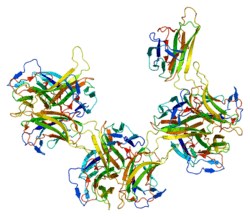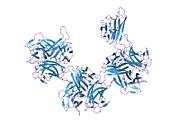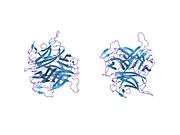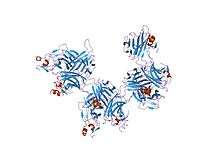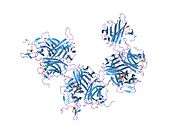B-cell activating factor
| View/Edit Human | View/Edit Mouse |
B-cell activating factor (BAFF) also known as tumor necrosis factor ligand superfamily member 13B is a protein that in humans is encoded by the TNFSF13B gene.[3][4] BAFF is also known as B Lymphocyte Stimulator (BLyS) and TNF- and APOL-related leukocyte expressed ligand (TALL-1) and the Dendritic cell-derived TNF-like molecule (CD257 antigen; cluster of differentiation 257).
Structure and function
BAFF is a cytokine that belongs to the tumor necrosis factor (TNF) ligand family. This cytokine is a ligand for receptors TNFRSF13B/TACI, TNFRSF17/BCMA, and TNFRSF13C/BAFF-R. This cytokine is expressed in B cell lineage cells, and acts as a potent B cell activator. It has been also shown to play an important role in the proliferation and differentiation of B cells.[5]
BAFF is a 285-amino acid long peptide glycoprotein which undergoes glycosylation at residue 124. It is expressed as a membrane-bound type II transmembrane protein [4] on various cell types including monocytes, dendritic cells and bone marrow stromal cells. The transmembrane form can be cleaved from the membrane, generating a soluble protein fragment. BAFF steady-state concentrations depend on B cells and also on the expression of BAFF-binding receptors.[6] BAFF is the natural ligand of three unusual tumor necrosis factor receptors named BAFF-R (BR3), TACI (transmembrane activator and calcium modulator and cyclophilin ligand interactor), and BCMA (B-cell maturation antigen), all of which have differing binding affinities for it. These receptors are expressed mainly on mature B lymphocytes and their expression varies in dependence of B cell maturation (TACI is also found on a subset of T-cells and BCMA on plasma cells). BAFF-R is involved in the positive regulation during B cell development.[7] TACI binds worst since its affinity is higher for a protein similar to BAFF, called a proliferation-inducing ligand (APRIL). BCMA displays an intermediate binding phenotype and will work with either BAFF or APRIL to varying degrees. Signaling through BAFF-R and BCMA stimulates B lymphocytes to undergo proliferation and to counter apoptosis. All these ligands act as homotrimers (i.e. three of the same molecule) interacting with homotrimeric receptors,[8] although BAFF has been known to be active as either a hetero- or homotrimer (can aggregate into 60-mer depending on the primary structure of the protein).[9]
Interactions
B-cell activating factor has been shown to interact with TNFRSF13B,[10][11] TNFSF13[12] and TNFRSF17.[13][14]
Interaction between BAFF and BAFF-R activates classical and noncanonical NF-κB signaling pathways. This interaction triggers signals essential for the formation and maintenance of B cell, thus it is important for a B-cell survival.[6]
Recombinant production
Human BLyS has been expressed and purified in E. Coli. The BLyS protein in the engineered bacteria can be as much as 50% to the bacteria’s total protein content and still retains activity after an purification procedure.[15]
Clinical significance
As an immunostimulant, BAFF (BLyS, TALL-1) is necessary for maintaining normal immunity. Inadequate level of BAFF will fail to activate B cells to produce enough immunoglobulin and will lead to immunodeficiency.
Excessive level of BAFF causes abnormally high antibody production, results in systemic lupus erythmatosis, rheumatoid arthritis, and many other autoimmune diseases.
Belimumab (Benlysta) is a monoclonal antibody developed by Human Genome Sciences and GlaxoSmithKline, with significant discovery input by Cambridge Antibody Technology, which specifically recognizes and inhibits the biological activity of B-Lymphocyte stimulator (BLyS) and is in clinical trials for treatment of Systemic lupus erythematosus and other auto-immune diseases.[16]
BAFF has been found in renal transplant biopsies with acute rejection and correlate with appearance C4d.[17] Increased levels of BAFF may initiate aloreactive B cell and T cell immunity, therefore may promote allograft rejection. Lower level of BAFF transcripts (or a higher level of soluble BAFF) show a higher risk of producing donor-specific antibodies in the investigated patients. Donor-specific antibodies bind with high affinity to the vascular endothelium of graft and activate complement. This process result in neutrophils infiltration, hemorrhage, fibrin deposition and platelet aggregation.[18] Targeting BAFF-R interactions may provide new therapeutic possibilities in transplantation.
Blisibimod, a fusion protein inhibitor of BAFF, is in development by Anthera Pharmaceuticals, also primarily for the treatment of systemic lupus erythematosus.[19]
BAFF may also be a new mediator of food-related inflammation.[20] Higher levels of BAFF are present in non-atopic compared with atopic patients, and there is not any correlation between BAFF and IgE, suggesting that BAFF might be particularly involved in non-IgE-mediated reactions.[21] BAFF is one of the most important cytokines involves in the modulation of the immune system and is deeply connected with food and nutrition; it is also produced by cells of bowel mucosa when some foods react with the innate immunity and determine inflammation. This fact is easy to understand, because BAFF had been first studied in patients with inflammatory bowel disease.[22] Moreover, in patients with celiac disease, serum BAFF levels are reduced after a gluten-free diet.[23] The same reduction can be present in the recently defined “Non Celiac Gluten sensitivity” (a reaction to gluten which provokes almost the same symptoms of celiac disease and could involve up to 20% of apparently healthy individuals.[24][25] The symptoms connected with this kind of food induced inflammatory phenomena, are often indistinguishable from symptoms of celiac disease. BAFF is also a specific inducer of insulin resistance and can be a strong link between inflammation and diabetes or obesity.[26][27] BAFF gives the organism a sort of danger signal and usually, according to the evolutionary theories, every human being responds to danger activating thrifty genes in order to store fat and to avoid starvation. BAFF shares many activities with PAF (Platelet Activating Factor) and they are both markers of non-IgE-mediated reactions in food-reactivity.[21]
References
- ↑ "Human PubMed Reference:".
- ↑ "Mouse PubMed Reference:".
- ↑ Shu HB, Hu WH, Johnson H (May 1999). "TALL-1 is a novel member of the TNF family that is down-regulated by mitogens". Journal of Leukocyte Biology. 65 (5): 680–3. PMID 10331498.
- 1 2 Schneider P, MacKay F, Steiner V, Hofmann K, Bodmer JL, Holler N, Ambrose C, Lawton P, Bixler S, Acha-Orbea H, Valmori D, Romero P, Werner-Favre C, Zubler RH, Browning JL, Tschopp J (Jun 1999). "BAFF, a novel ligand of the tumor necrosis factor family, stimulates B cell growth". The Journal of Experimental Medicine. 189 (11): 1747–56. doi:10.1084/jem.189.11.1747. PMC 2193079
 . PMID 10359578.
. PMID 10359578. - ↑ "Entrez Gene: tumor necrosis factor (ligand) superfamily".
- 1 2 Kreuzaler M, Rauch M, Salzer U, Birmelin J, Rizzi M, Grimbacher B, Plebani A, Lougaris V, Quinti I, Thon V, Litzman J, Schlesier M, Warnatz K, Thiel J, Rolink AG, Eibel H (Jan 2012). "Soluble BAFF levels inversely correlate with peripheral B cell numbers and the expression of BAFF receptors". Journal of Immunology. 188 (1): 497–503. doi:10.4049/jimmunol.1102321. PMID 22124120.
- ↑ Thibault-Espitia A, Foucher Y, Danger R, Migone T, Pallier A, Castagnet S, G-Gueguen C, Devys A, C-Gautier A, Giral M, Soulillou JP, Brouard S (Oct 2012). "BAFF and BAFF-R levels are associated with risk of long-term kidney graft dysfunction and development of donor-specific antibodies". American Journal of Transplantation. 12 (10): 2754–62. doi:10.1111/j.1600-6143.2012.04194.x. PMID 22883025.
- ↑ Oren DA, Li Y, Volovik Y, Morris TS, Dharia C, Das K, Galperina O, Gentz R, Arnold E (Apr 2002). "Structural basis of BLyS receptor recognition". Nature Structural Biology. 9 (4): 288–92. doi:10.1038/nsb769. PMID 11862220.
- ↑ Daridon C, Youinou P, Pers JO (Feb 2008). "BAFF, APRIL, TWE-PRIL: who's who?". Autoimmunity Reviews. 7 (4): 267–71. doi:10.1016/j.autrev.2007.05.002. PMID 18295728.
- ↑ Wu Y, Bressette D, Carrell JA, Kaufman T, Feng P, Taylor K, Gan Y, Cho YH, Garcia AD, Gollatz E, Dimke D, LaFleur D, Migone TS, Nardelli B, Wei P, Ruben SM, Ullrich SJ, Olsen HS, Kanakaraj P, Moore PA, Baker KP (Nov 2000). "Tumor necrosis factor (TNF) receptor superfamily member TACI is a high affinity receptor for TNF family members APRIL and BLyS". The Journal of Biological Chemistry. 275 (45): 35478–85. doi:10.1074/jbc.M005224200. PMID 10956646.
- ↑ Xia XZ, Treanor J, Senaldi G, Khare SD, Boone T, Kelley M, Theill LE, Colombero A, Solovyev I, Lee F, McCabe S, Elliott R, Miner K, Hawkins N, Guo J, Stolina M, Yu G, Wang J, Delaney J, Meng SY, Boyle WJ, Hsu H (Jul 2000). "TACI is a TRAF-interacting receptor for TALL-1, a tumor necrosis factor family member involved in B cell regulation". The Journal of Experimental Medicine. 192 (1): 137–43. doi:10.1084/jem.192.1.137. PMC 1887716
 . PMID 10880535.
. PMID 10880535. - ↑ Roschke V, Sosnovtseva S, Ward CD, Hong JS, Smith R, Albert V, Stohl W, Baker KP, Ullrich S, Nardelli B, Hilbert DM, Migone TS (Oct 2002). "BLyS and APRIL form biologically active heterotrimers that are expressed in patients with systemic immune-based rheumatic diseases". Journal of Immunology. 169 (8): 4314–21. doi:10.4049/jimmunol.169.8.4314. PMID 12370363.
- ↑ Liu Y, Hong X, Kappler J, Jiang L, Zhang R, Xu L, Pan CH, Martin WE, Murphy RC, Shu HB, Dai S, Zhang G (May 2003). "Ligand-receptor binding revealed by the TNF family member TALL-1". Nature. 423 (6935): 49–56. doi:10.1038/nature01543. PMID 12721620.
- ↑ Shu HB, Johnson H (Aug 2000). "B cell maturation protein is a receptor for the tumor necrosis factor family member TALL-1". Proceedings of the National Academy of Sciences of the United States of America. 97 (16): 9156–61. doi:10.1073/pnas.160213497. PMC 16838
 . PMID 10908663.
. PMID 10908663. - ↑ Tian RY, Han W, Yu Y, Chen Y, Yu GS, Yang SL, Gong Y (Dec 2003). "[The immunopotentiation of human B lymphocyte stimulator C-terminal peptide]". Sheng Wu Hua Xue Yu Sheng Wu Wu Li Xue Bao Acta Biochimica et Biophysica Sinica. 35 (12): 1128–32. PMID 14673506.
- ↑ Navarra SV, Guzmán RM, Gallacher AE, Hall S, Levy RA, Jimenez RE, Li EK, Thomas M, Kim HY, León MG, Tanasescu C, Nasonov E, Lan JL, Pineda L, Zhong ZJ, Freimuth W, Petri MA (Feb 2011). "Efficacy and safety of belimumab in patients with active systemic lupus erythematosus: a randomised, placebo-controlled, phase 3 trial". Lancet. 377 (9767): 721–31. doi:10.1016/S0140-6736(10)61354-2. PMID 21296403.
- ↑ Banham G, Prezzi D, Harford S, Taylor CJ, Hamer R, Higgins R, Bradley JA, Clatworthy MR (Aug 2013). "Elevated pretransplantation soluble BAFF is associated with an increased risk of acute antibody-mediated rejection". Transplantation. 96 (4): 413–20. doi:10.1097/TP.0b013e318298dd65. PMID 23842189.
- ↑ Wasowska BA (Jul 2010). "Mechanisms involved in antibody- and complement-mediated allograft rejection". Immunologic Research. 47 (1-3): 25–44. doi:10.1007/s12026-009-8136-3. PMC 2892186
 . PMID 20135240.
. PMID 20135240. - ↑ ClinicalTrials.gov. "PEARL-SC Trial: A Study of the Efficacy, Safety, and Tolerability of A 623 Administration in Subjects With Systemic Lupus Erythematosus.". United States National Institute of Health. Retrieved 2011-07-15.
- ↑ Lied GA, Berstad A (Jan 2011). "Functional and clinical aspects of the B-cell-activating factor (BAFF): a narrative review". Scandinavian Journal of Immunology. 73 (1): 1–7. doi:10.1111/j.1365-3083.2010.02470.x. PMID 21128997.
- 1 2 Piuri G, Soriano J, Speciani MC, Speciani AF (2013). "B cell activating factor (BAFF) and platelet activating factor (PAF) could both be markers of non-IgE-mediated reactions". Clinical and Translational Allergy. 3 (Suppl 3): O5. doi:10.1186/2045-7022-3-S3-O5. PMC 3723786
 .
. - ↑ Lied GA, Lillestøl K, Valeur J, Berstad A (Jul 2010). "Intestinal B cell-activating factor: an indicator of non-IgE-mediated hypersensitivity reactions to food?". Alimentary Pharmacology & Therapeutics. 32 (1): 66–73. doi:10.1111/j.1365-2036.2010.04314.x. PMID 20353497.
- ↑ Fabris M, Visentini D, De Re V, Picierno A, Maieron R, Cannizzaro R, Villalta D, Curcio F, De Vita S, Tonutti E (Dec 2007). "Elevated B cell-activating factor of the tumour necrosis factor family in coeliac disease". Scandinavian Journal of Gastroenterology. 42 (12): 1434–9. doi:10.1080/00365520701452225. PMID 17852877.
- ↑ Sapone A, Bai JC, Ciacci C, Dolinsek J, Green PH, Hadjivassiliou M, Kaukinen K, Rostami K, Sanders DS, Schumann M, Ullrich R, Villalta D, Volta U, Catassi C, Fasano A (2012). "Spectrum of gluten-related disorders: consensus on new nomenclature and classification". BMC Medicine. 10: 13. doi:10.1186/1741-7015-10-13. PMC 3292448
 . PMID 22313950.
. PMID 22313950. - ↑ Aziz I, Hadjivassiliou M, Sanders DS (2012). "Does gluten sensitivity in the absence of coeliac disease exist?". BMJ. 345: e7907. doi:10.1136/bmj.e7907. PMID 23204002.
- ↑ Kim YH, Choi BH, Cheon HG, Do MS (Mar 2009). "B cell activation factor (BAFF) is a novel adipokine that links obesity and inflammation". Experimental & Molecular Medicine. 41 (3): 208–16. doi:10.3858/emm.2009.41.3.024. PMC 2679246
 . PMID 19293640.
. PMID 19293640. - ↑ Hamada M, Abe M, Miyake T, Kawasaki K, Tada F, Furukawa S, Matsuura B, Hiasa Y, Onji M (Oct 2011). "B cell-activating factor controls the production of adipokines and induces insulin resistance". Obesity. 19 (10): 1915–22. doi:10.1038/oby.2011.165. PMID 21701571.
Further reading
- Nardelli B, Moore PA, Li Y, Hilbert DM (Jul 2002). "B lymphocyte stimulator (BLyS): a therapeutic trichotomy for the treatment of B lymphocyte diseases". Leukemia & Lymphoma. 43 (7): 1367–73. doi:10.1080/10428190290033297. PMID 12389615.
- Zhou T, Zhang J, Carter R, Kimberly R (2003). "BLyS and B cell autoimmunity". Current Directions in Autoimmunity. 6: 21–37. doi:10.1159/000066854. PMID 12408045.
- Stohl W (2005). "A therapeutic role for BLyS antagonists". Lupus. 13 (5): 317–22. doi:10.1191/0961203304lu1019oa. PMID 15230285.
- Quartuccio L, Fabris M, Ferraccioli G (2004). "[B lymphocyte stimulator (BLyS) and monocytes: possible role in autoimmune diseases with a particular reference to rheumatoid arthritis]". Reumatismo. 56 (3): 143–6. doi:10.4081/reumatismo.2004.143. PMID 15470519.
- Sutherland AP, Mackay F, Mackay CR (Dec 2006). "Targeting BAFF: immunomodulation for autoimmune diseases and lymphomas". Pharmacology & Therapeutics. 112 (3): 774–86. doi:10.1016/j.pharmthera.2006.06.002. PMID 16863659.
- Bossen C, Schneider P (Oct 2006). "BAFF, APRIL and their receptors: structure, function and signaling". Seminars in Immunology. 18 (5): 263–75. doi:10.1016/j.smim.2006.04.006. PMID 16914324.
- Brink R (Oct 2006). "Regulation of B cell self-tolerance by BAFF". Seminars in Immunology. 18 (5): 276–83. doi:10.1016/j.smim.2006.04.003. PMID 16916609.
- Tangye SG, Bryant VL, Cuss AK, Good KL (Oct 2006). "BAFF, APRIL and human B cell disorders". Seminars in Immunology. 18 (5): 305–17. doi:10.1016/j.smim.2006.04.004. PMID 16916610.
- Treml LS, Crowley JE, Cancro MP (Oct 2006). "BLyS receptor signatures resolve homeostatically independent compartments among naïve and antigen-experienced B cells". Seminars in Immunology. 18 (5): 297–304. doi:10.1016/j.smim.2006.07.001. PMID 16919470.
- Woodland RT, Schmidt MR, Thompson CB (Oct 2006). "BLyS and B cell homeostasis". Seminars in Immunology. 18 (5): 318–26. doi:10.1016/j.smim.2006.06.001. PMID 16931037.
- Kalled SL (Oct 2006). "Impact of the BAFF/BR3 axis on B cell survival, germinal center maintenance and antibody production". Seminars in Immunology. 18 (5): 290–6. doi:10.1016/j.smim.2006.06.002. PMID 16931038.
- Mackay F, Leung H (Oct 2006). "The role of the BAFF/APRIL system on T cell function". Seminars in Immunology. 18 (5): 284–9. doi:10.1016/j.smim.2006.04.005. PMID 16931039.
- Bosello S, Pers JO, Rochas C, Devauchelle V, De Santis M, Daridon C, Saraux A, Ferraccioli GF, Youinou P (2007). "BAFF and rheumatic autoimmune disorders: implications for disease management and therapy". International Journal of Immunopathology and Pharmacology. 20 (1): 1–8. PMID 17346422.
- Mukhopadhyay A, Ni J, Zhai Y, Yu GL, Aggarwal BB (Jun 1999). "Identification and characterization of a novel cytokine, THANK, a TNF homologue that activates apoptosis, nuclear factor-kappaB, and c-Jun NH2-terminal kinase". The Journal of Biological Chemistry. 274 (23): 15978–81. doi:10.1074/jbc.274.23.15978. PMID 10347144.
- Moore PA, Belvedere O, Orr A, Pieri K, LaFleur DW, Feng P, Soppet D, Charters M, Gentz R, Parmelee D, Li Y, Galperina O, Giri J, Roschke V, Nardelli B, Carrell J, Sosnovtseva S, Greenfield W, Ruben SM, Olsen HS, Fikes J, Hilbert DM (Jul 1999). "BLyS: member of the tumor necrosis factor family and B lymphocyte stimulator". Science. 285 (5425): 260–3. doi:10.1126/science.285.5425.260. PMID 10398604.
- Tribouley C, Wallroth M, Chan V, Paliard X, Fang E, Lamson G, Pot D, Escobedo J, Williams LT (Dec 1999). "Characterization of a new member of the TNF family expressed on antigen presenting cells". Biological Chemistry. 380 (12): 1443–7. doi:10.1515/BC.1999.186. PMID 10661873.
- Gross JA, Johnston J, Mudri S, Enselman R, Dillon SR, Madden K, Xu W, Parrish-Novak J, Foster D, Lofton-Day C, Moore M, Littau A, Grossman A, Haugen H, Foley K, Blumberg H, Harrison K, Kindsvogel W, Clegg CH (Apr 2000). "TACI and BCMA are receptors for a TNF homologue implicated in B-cell autoimmune disease". Nature. 404 (6781): 995–9. doi:10.1038/35010115. PMID 10801128.
- Shu HB, Johnson H (Aug 2000). "B cell maturation protein is a receptor for the tumor necrosis factor family member TALL-1". Proceedings of the National Academy of Sciences of the United States of America. 97 (16): 9156–61. doi:10.1073/pnas.160213497. PMC 16838
 . PMID 10908663.
. PMID 10908663.
External links
- B-Cell Activating Factor at the US National Library of Medicine Medical Subject Headings (MeSH)
